ESP8266 WiFi modules initially stormed the maker market for IoT applications thanks to their low price, and later it became the dominant WiFi IoT platform for hobbyists thanks to its large community of developers. But technology progresses over time, and it’s always fun to look out for new solutions, and Realtek RTL8710 could prove to be an interesting alternative with its ARM Cortex-M3 processor @ 166 MHz, a little more user memory (48KB), audio support, faster WiFi performance.
Realtek RTL8710 WiFi IoT modules came out as potential competitors to ESP8266 modules last month, with similar features. an ARM Cortex M3, and a pricing as low as $2 in quantities. However, documentation is often in Chinese only, and based on my experience with an RTL8710AF module limited to AT commands set for now. Software and documentation are likely to improve a lot however, as Pine64, the makers of Pine A64 boards, are about to launch their own “PADI IoT Stamp” RTL8710AF module for just $1.99 in any quantities.

PADI IoT Stamp specifications:
- SoC – Realtek RTL8710AF ARM Cortex-M3 @ 83 MHz with 1 MB ROM, 512 KB RAM, and 1 MB flash
- Connectivity – 802.11 b/g/n WiFi @ 2.4 GHz – 2.5 GHz (2400 MHz – 2483.5 MHz) with PCB antenna; Station / SoftAP / SoftAP + Station modes;
- Expansion headers – 22 half-holes with
- Up to 1x SPI @ 41.5 Mbps max
- Up to 3x UART with 2x up to 4 Mbps, 1x @ 38400 bps
- Up to 4x PWM
- Up to 1x I2C @ 3.4 Mbps max
- Up to 19 GPIOs including 10 supporting interrupts
- Power Supply – 3.0 to 3.6 V (3.3 V recommended)
- Power Consumption – 87 mA typ. @ 3.3V using 802.11b 11 Mbps, +17 dBm; 0.9 mA light sleep; 10 uA deep sleep; More details on Section 6 of the datasheet.
- Dimensions – 24×16 mm
- Temperature range – -20 ℃ ~ 85 ℃
If the hardware looks familiar, it’s because it also most the same as B&T RTL-00 module. However, I’ve been told it might not be 100% compatible, so mixing firmware for different modules may potentially brick them. The module can be programmed and debugged using IAR, openOCD, and/or J-Link, and it supports firmware updates via UART, OTA, and JTAG. Currently, the company provides a download link to Ameba Standard SDK based on FreeRTOS and LWIP, but ARM mbed 5.0 support is planned in the coming months. [Update:Ameba RTL8710AF SDK ver v3.5a GCC ver 1.0.0- without NDA has been uploaded recently] Configuration can be done through AT Commands, Cloud Server, or Android / iOS mobile app.
You’ll find documentation in English and tools on PADI IoT Stamp product page, including the datasheet, a guide start guide with AT commands, Ameba SDK 3.4b3, and some tools and drivers for the serial console. The module will officially launch on September 14th, and you’ll be able to purchase it for $1.99 plus shipping. The company is also working on a breadboard-friendly NodeMCU like board featuring PADI IoT Stamp, but I don’t have further info about this board at this stage.
In somewhat other news, some people submitted both RTL8710AF and RTL8711AF processors to a X-Ray machine, and while the latter has more features such as NFC support, it appears both SoCs look exactly the same under X-Ray, so RTL8710AF might actually have the exact same features, but they are just disabled.

